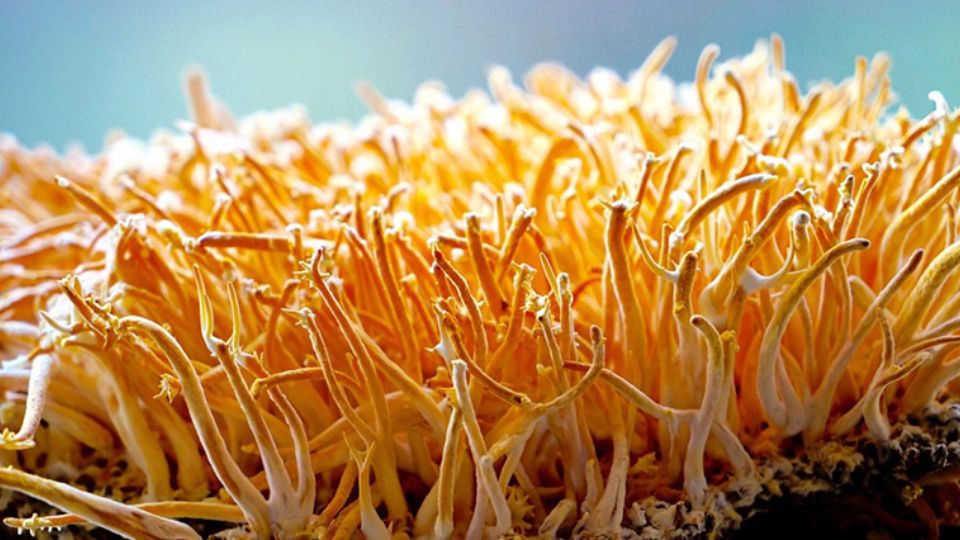Growing Cordyceps – In Jars and Bulk Bins
Growing your own Cordyceps can be thrilling and adventurous. These mushrooms are gaining popularity, showing up in various supplements, and becoming a hot topic in the mushroom community. Despite their insect-related origin, there’s a species called Cordyceps militaris that shares the same medicinal qualities and can be commercially grown—no insects needed.
In this article, we’ll guide you step-by-step on growing Cordyceps militaris at home. No horror stories, just the magic of growing mushrooms.
In this article:
Growing Cordyceps – Two Best Ways
Two popular methods for cultivation are the liquid culture and jar or bin tech methods.
Method 1: Growing Cordyceps in Jars
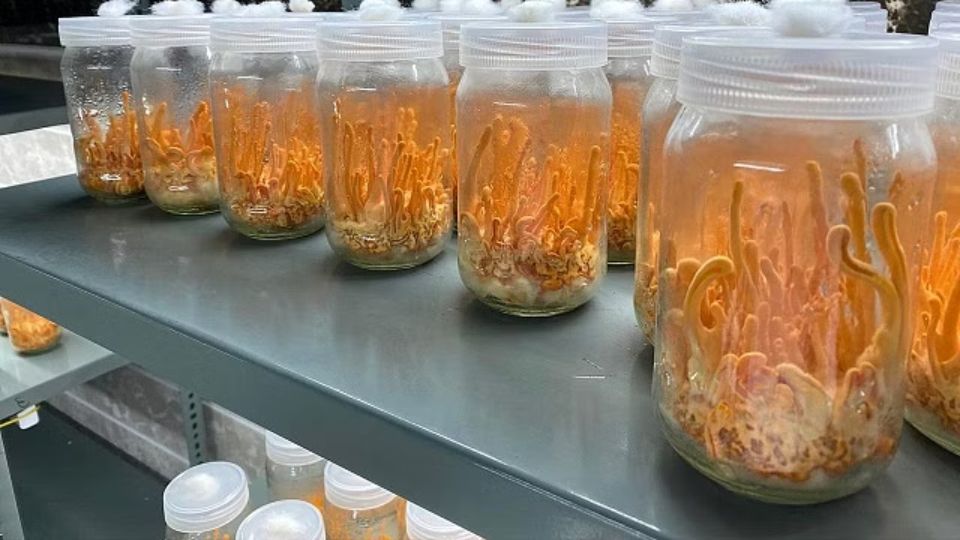
Ready to embark on a journey into the magical world of cultivating Cordyceps militaris in your own home? Well, hold on tight because we’ve got some detailed instructions for you!
First things first, grab your jar, let’s get started. We’re going to transform that humble jar into a cozy home for our fascinating fungus friend.
Materials:
- 500 ml Water
- 1 TBS Light malt extract
- 1 TBS Nutritional Yeast
- 35 Grams Brown Rice Per Pint Jar
- 10-12 ml Liquid Culture Per Jar
Instructions:
1. Preparing the Liquid Culture
- Dissolve one tablespoon of honey in 600 milliliters of warm water to create a liquid culture solution.
- Sterilize the solution at 15 psi for 30 minutes.
- Inoculate the sterilized honey water with 1-2 milliliters of Cordyceps militaris liquid culture.
- Incubate the mixture in darkness at temperatures below 70 degrees Fahrenheit.
2. Creating the Substrate and Broth
- Blend one liter of water, two tablespoons of light malt extract, and two tablespoons of yeast extract.
- Add five cups of brown rice to the mixture and cook it using an instant rice cooker.
- Allow the cooked rice to cool down.
3. Preparing the Jars
- Transfer the cooled cooked rice to a sterilized container.
- Add 250 milliliters of liquid culture to the container.
- Cover the holes on the lid with micropore tape.
4. Individual Jar Method
- Take a pint jar and fill it with 35 grams of brown rice.
- Add 45 milliliters of the prepared broth to the jar.
- Sterilize the jar at 15 psi for 45 minutes.
5. Inoculation and Incubation
- Inoculate the cooled jar with Cordyceps militaris liquid culture.
- Incubate the jar in darkness for three days.
- Wrap an LED light strip around the jar to initiate fruiting.
6. Fruiting Stage
- Maintain temperatures between 65 and 68 degrees Fahrenheit during fruiting.
- After approximately 14 days, pinning (initial mushroom formation) should occur.
7. Maturation and Harvesting
- Cordyceps militaris mushrooms will be fully mature between the 50th and 60th day of growth.
- Harvest the mature mushrooms and enjoy their medicinal benefits.
BOTTOM LINE
Maintaining sterility throughout the process is crucial for successful Cordyceps cultivation. Be mindful of cleanliness, follow proper sterilization techniques, and ensure the recommended temperature range of 65-68 degrees Fahrenheit during fruiting for optimal results.
Method 2: Growing Cordyceps With Bulk Bins
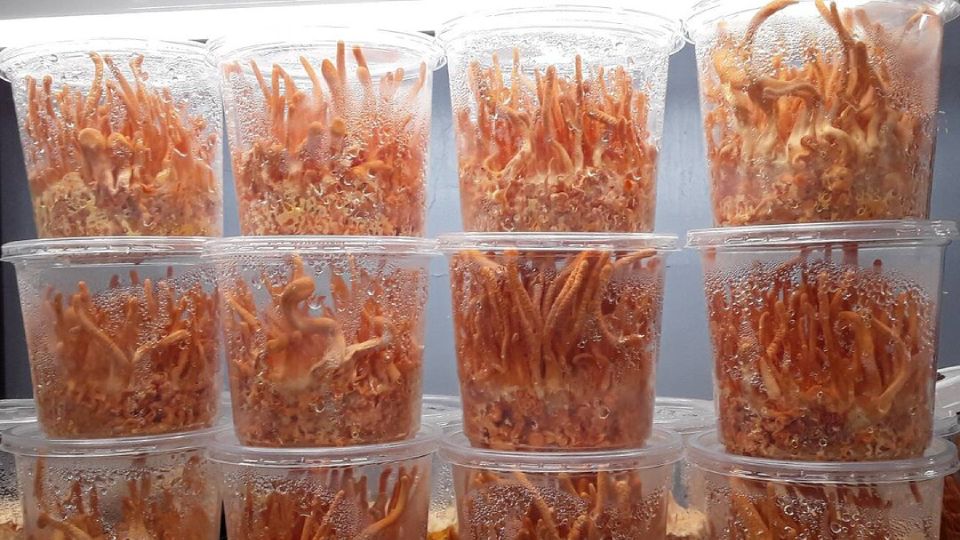
Alright, folks, get ready for some bulk bin magic! Let’s break it down step by step.
Materials:
- 1 Liter Water
- 2 tablespoons Light Malt Extract
- 2 tablespoons Nutritional Yeast
- 5 cups Brown Rice
- 250 ml Liquid Culture
Instructions:
1. Prepare the Liquid Culture
- Dissolve one tablespoon of honey in 600 milliliters of warm water to create the liquid culture base.
- Sterilize the liquid culture at 15 psi for 30 minutes to ensure a sterile environment.
- Inoculate the sterilized honey water with 1-2 milliliters of Cordyceps militaris liquid culture.
- Incubate the liquid culture in a dark place at temperatures below 70 degrees Fahrenheit (21 degrees Celsius).
2. Prepare the Substrate and Broth
In a blender, combine one liter of water, two tablespoons of light malt extract, and two tablespoons of yeast extract.
- Add five cups of brown rice to the mixture and cook it in an instant rice cooker.
- Once the rice has cooked, allow it to cool down to room temperature.
3. Transfer the Rice to a Sterilite Container
- Take a sterilite container and add 250 milliliters of liquid culture to it.
- Transfer the cooled cooked rice into the sterilite container.
- Cover the holes on the container’s lid with micropore tape to maintain a clean environment.
4. Incubation and Fruiting
- Place the sterilite container in a dark area with temperatures between 65 and 68 degrees Fahrenheit (18-20 degrees Celsius).
- Maintain the container in the dark for three days to allow colonization.
- After three days, wrap an LED light strip around the bin to initiate fruiting.
- Continue to incubate the bin in the same temperature range.
5. Pinning and Maturation
- After approximately 14 days of pinning, the formation of tiny mushroom pins should occur.
- Continue to maintain the temperature and provide appropriate humidity levels for the fruiting process.
- Cordyceps militaris mushrooms will mature between the 50th and 60th day of growth.
IMPORTANT
Remember to maintain sterile conditions throughout the process, provide the necessary environmental conditions, and exercise patience during the growth stages. With proper care and attention, you can enjoy the harvest of these valuable and medicinal Cordyceps mushrooms.
Tips for Growing Cordyceps
Creating a nutrient broth is essential for cordyceps growth. This broth provides the necessary nutrients for the fungus to thrive and develop into its fruiting body. The recipe for a nutrient broth typically includes organic ingredients such as malt extract, peptone, and yeast extract. Sterilization of the broth is vital to prevent contamination and ensure optimal growth conditions.
What is Cordyceps?
Cordyceps is a genus of parasitic fungi that exhibit a fascinating life cycle. These captivating fungi have a penchant for infecting insects and other creepy crawlies, leading to some truly mind-boggling transformations. Among the famous species, Cordyceps sinensis and Cordyceps militaris reign supreme, thriving in the majestic mountainous regions of Tibet and Nepal. These clever fungi set their sights on unsuspecting caterpillars, infiltrating their bodies and sprouting slender stems that reach for the sky.
Health Benefits of Cordyceps
- Immune Function: Enhances immunity against illnesses by stimulating immune cells and chemicals.
- Aging and Mental Clarity: Promotes longevity and mental sharpness by optimizing bodily systems’ health[1].
- Athletic Performance: Believed to increase ATP production, enhancing muscle energy and exercise endurance[2].
- Sexual Function: Traditional use suggests effectiveness in addressing low libido and sexual problems[3].
- Inflammation Reduction: Exhibits anti-inflammatory properties, aiding in alleviating body inflammation[4].
- Heart Health: May prevent arrhythmias, lower triglyceride levels, reduce “bad” LDL cholesterol, and protect the heart.
- Blood Sugar Regulation: Assists in regulating blood sugar levels, especially in individuals with type 2 diabetes[5].
- Anti-Cancer Properties: Preliminary studies suggest potential in combating cancer cells and reducing tumor size, particularly in lung and skin cancers[6].
- Anti-Fatigue: Combats fatigue and provides a natural energy boost.
Remember, most research on Cordyceps has been conducted on animals or in labs. More research is needed to fully understand its health benefits and potential side effects.
Different Types of Cordyceps
Cordyceps offers over 400 different species. However, you’ll find two main species that capture human interest: Cordyceps sinensis and Cordyceps militaris. Cordyceps sinensis, a rare and costly species, thrives in the wild on the Tibetan plateau. On the other hand, Cordyceps militaris, commercially cultivated on a large scale, provides an accessible and affordable option for your home cultivation or supplement needs.
When it comes to growing Cordyceps at home, Cordyceps militaris takes the lead, offering various cultivation methods. Keep in mind that other types of Cordyceps exist, such as Cordyceps mycelium grown in large liquid vats called CS-4. However, in herbalism, it’s Cordyceps militaris that shines and gains popularity in the Western world. So, if you’re looking to explore the incredible benefits of Cordyceps, this species holds the key to unlocking its wonders.
Research on Cordyceps Benefits
Cordyceps is not just any ordinary mushroom, it’s a fungal superstar with a variety of health benefits that have caught the attention of researchers worldwide. When it comes to improving our well-being, cordyceps doesn’t mess around! Numerous scientific studies have provided solid evidence for its positive effects on respiratory function, cardiovascular health, and even athletic performance[7]. It’s like a personal trainer for your body, helping you go that extra mile (quite literally!). But that’s not all—cordyceps also flexes its medicinal muscles with antiviral, antimicrobial, and anticancer properties. It’s like the superhero of mushrooms, fighting off the bad guys and boosting your health. So, don’t underestimate the power of this tiny fungus—it’s here to save the day!
Traditional Uses of Cordyceps
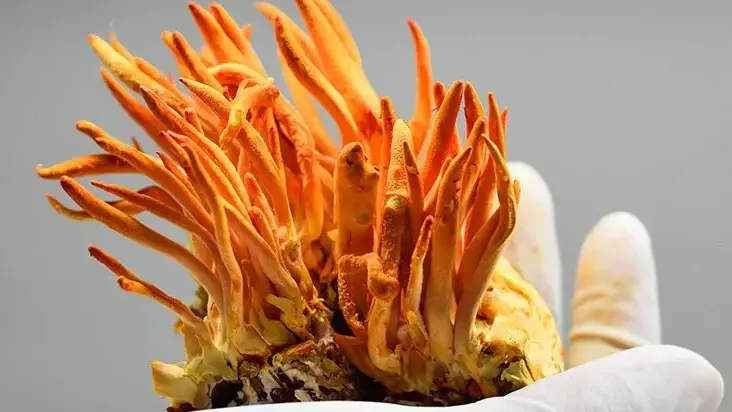
1. Anti-fatigue
When it comes to banishing fatigue, Cordyceps has quite the reputation. Picture this: Cordyceps teams up with ginseng and Rhodiola rosea, forming a dream team to combat tiredness. It’s believed that Cordyceps can boost energy levels and improve exercise performance. So, if you need an extra oomph in your step, Cordyceps might just be the fungi for you[8].
2. Kidney disease
Ah, the mighty kidney warriors! Cordyceps has long been used in Traditional Chinese Medicine to tackle kidney disease. It’s believed to have a protective effect on these vital organs, potentially improving kidney function. Now, that’s some fungi power-packed into those tiny organisms[9].
3. Low sex drive
When the flames of desire need a little coaxing, Cordyceps steps in. In Traditional Chinese Medicine, Cordyceps has been employed to revitalize low sex drive. It’s said to possess aphrodisiac properties that may enhance sexual function. It’s like a little boost of romance from the fungal world!
It’s important to note that much of the research on their health benefits is limited to animal or lab studies. So while Cordyceps shows promise, we’re still waiting for more concrete evidence on its effects in humans.
Ways to Consume Cordyceps
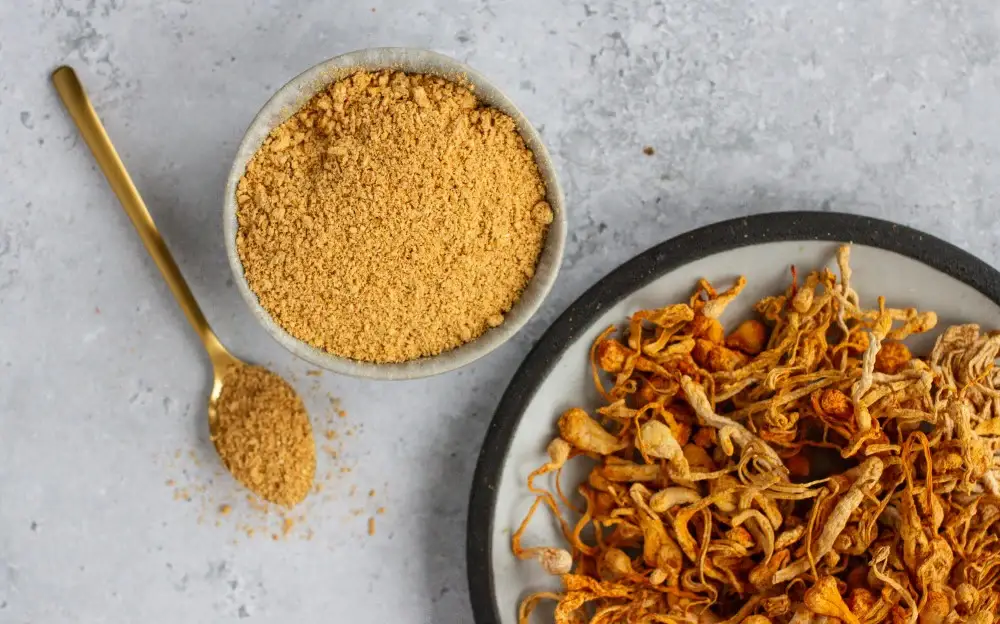
Consume Fresh Cordyceps
When cooked fresh, Cordyceps mushrooms are a delightful addition to your dishes. However, they dry out quickly, so it’s best to use them within a day or two. These mild mushrooms offer a generic mushroom flavor, but what’s even better is that they bring along all the medicinal benefits. Add them to your favorite pasta or stir-fry, and let the magic unfold. To ensure thorough cooking, we recommend pan frying them or incorporating them into dishes that simmer for at least 30 to 60 minutes.
Consume Dried Cordyceps
If you want to preserve Cordyceps for a longer period, drying is the way to go. Lay the mushrooms on a cookie sheet and let them dry completely, which may take several days. Alternatively, you can use a dehydrator set at 100 degrees F for around 15 hours. Once dried, store the Cordyceps in a resealable freezer bag with silica gel packets. These packets are important as dried mushrooms easily absorb moisture from the air. By keeping your dried Cordyceps in a cool, dry, and dark place, you can enjoy their goodness for up to a year.
Make Cordyceps Tea
Cordyceps tea is a popular way to consume this magnificent mushroom. Simply make it with whole dried Cordyceps mushrooms. It’s a breeze to prepare, and after sipping a cup, you’ll feel invigorated and refreshed.
Take Cordyceps Capsules
For convenient and easy consumption, Cordyceps is also available in capsule form. These capsules contain powdered Cordyceps extract, allowing you to enjoy the benefits of this mushroom with simplicity and precision. Follow the recommended dosage instructions provided by the manufacturer for optimal results.
Enjoy Cordyceps Coffee
If you’re a coffee lover, why not combine your favorite beverage with the goodness of Cordyceps? Cordyceps coffee blends the rich flavor of coffee with the health-enhancing properties of Cordyceps extract. It’s a delightful way to kick-start your day while reaping the benefits of this remarkable mushroom. Simply brew it like regular coffee and savor the unique combination.
Add Cordyceps Powder
Another convenient option is Cordyceps powder. This fine powder is made from dried Cordyceps mushrooms and can be easily incorporated into various recipes and beverages. Add it to smoothies, and soups, or sprinkle it over your favorite dishes to enjoy the health benefits of Cordyceps in a versatile and easy-to-use form.
Whether you choose to cook with fresh Cordyceps, preserve them by drying, sip on comforting Cordyceps tea, opt for convenient capsules, indulge in the fusion of Cordyceps coffee, or explore the versatility of Cordyceps powder, there’s a method that suits everyone’s preferences.
The choice of consumption method depends on personal preference and desired outcomes. Regardless of the form, it is essential to follow recommended dosages and guidelines for safe and effective use.
Best Time to Take Cordyceps
You can take Cordyceps at any time of the day that suits you best. Many individuals find it energizing and choose to consume it in the morning or prior to their workouts. If you find the flavor to be strong, mixing Cordyceps with water or opting for the capsule form can help mask the taste and make it more palatable. Ultimately, the choice of when to take Cordyceps depends on your personal preferences and desired effects. Experiment and find the timing that works perfectly for you.
FAQs
Are Cordyceps Easy to Grow?
Growing Cordyceps can be challenging because it requires specific conditions, such as high-altitude temperatures and a host insect. It’s more feasible to grow the mycelium of Cordyceps militaris, a related species, indoors on a suitable substrate. While it’s not as complex as growing wild Cordyceps, it still requires expertise and controlled conditions.
What Are the Drawbacks of Cordyceps?
Common drawbacks of Cordyceps may include mild side effects like digestive issues or allergic reactions in some individuals. It can also interact with certain medications, so consulting a healthcare professional before use is advisable. Additionally, Cordyceps products can be expensive due to the difficulty of cultivation.
Can You Eat Cordyceps Raw?
The fruit body of a cordyceps mushroom is safe to eat raw. However, eating raw Cordyceps is not recommended due to its tough and potentially indigestible nature. It’s typically consumed after being processed into supplements, extracts, or added to cooked dishes. Add them to soup, or sprinkle a little bit of the medicinal dried mushroom on your favorite pizza or dish.
Where Do Cordyceps Grow Naturally?
Cordyceps grow naturally in high-altitude regions of Asia, particularly the Himalayas and Tibet. They parasitize insects and other arthropods, which is why they’re sometimes called “caterpillar fungi.” These unique conditions contribute to the growth of wild Cordyceps, making them highly prized in traditional medicine.
Conclusion on Growing Cordyceps
In conclusion, growing cordyceps opens a fascinating door to exploring the world of medicinal mushrooms. With its rich history, remarkable health benefits, and diverse cultivation methods, cordyceps captivates both scientific curiosity and holistic wellness enthusiasts. By dispelling misconceptions, embracing evidence-based research, and cultivating cordyceps on a commercial scale, we can unlock its vast potential and make this extraordinary fungus more accessible to individuals seeking natural health and vitality.
References
1. Nanoencapsulated Cordyceps Extract Enhances Collagen Synthesis and Skin Cell Regeneration through Antioxidation and Autophagy. Retrieved from https://www.researchgate.net/publication/369667446_Nanoencapsulated_Cordyceps_Extract_Enhances_Collagen_Synthesis_and_Skin_Cell_Regeneration_through_Antioxidation_and_Autophagy
2. Rhodiola crenulata- and Cordyceps sinensis-Based Supplement Boosts Aerobic Exercise Performance after Short-Term High Altitude Training. Retrieved from https://www.ncbi.nlm.nih.gov/pmc/articles/PMC4174424/
3. Effects of Cultured Cordycep militaris on Sexual Performance and Erectile Function in Streptozotocin-Induced Diabetic Male Rats. Retrieved from https://www.researchgate.net/publication/346982880_Effects_of_Cultured_Cordycep_militaris_on_Sexual_Performance_and_Erectile_Function_in_Streptozotocin-Induced_Diabetic_Male_Rats
4. Bioconversion of Ginsenoside Rf into Its Hydrated Derivative with Elevated Anti-inflammatory Effect by a Highly Specific Biocatalytic System of Cordyceps Sinensis. Retrieved from https://www.researchgate.net/publication/368986354_Bioconversion_of_Ginsenoside_Rf_into_Its_Hydrated_Derivative_with_Elevated_Anti-inflammatory_Effect_by_a_Highly_Specific_Biocatalytic_System_of_Cordyceps_Sinensis
5. Improvement of Insulin Resistance and Insulin Secretion by Water Extracts of Cordyceps militaris, Phellinus linteus, and Paecilomyces tenuipes in 90% Pancreatectomized Rats. Retrieved from https://www.jstage.jst.go.jp/article/bbb/68/11/68_11_2257/_article/-char/en
6. Optimal conditions for cordycepin production in surface liquid-cultured Cordyceps militaris treated with porcine liver extracts for suppression of oral cancer. Retrieved from https://www.sciencedirect.com/science/article/pii/S1021949817300352
7. Enhancing Neurological Competence of Nanoencapsulated Cordyceps/Turmeric Extracts in Human Neuroblastoma SH-SY5Y Cells. Retrieved from https://www.researchgate.net/publication/366239806_Enhancing_Neurological_Competence_of_Nanoencapsulated_CordycepsTurmeric_Extracts_in_Human_Neuroblastoma_SH-SY5Y_Cells
8. Effects of the Mycelial Extract of Cultured Cordyceps Sinensis on In Vivo Hepatic Energy Metabolism in the Mouse. Retrieved from https://www.jstage.jst.go.jp/article/jphs1951/70/1/70_1_85/_article/-char/en
9. Cordyceps militaris Improves Chronic Kidney Disease by Affecting TLR4/NF-κB Redox Signaling Pathway. Retrieved from https://www.ncbi.nlm.nih.gov/pmc/articles/PMC6462325/

